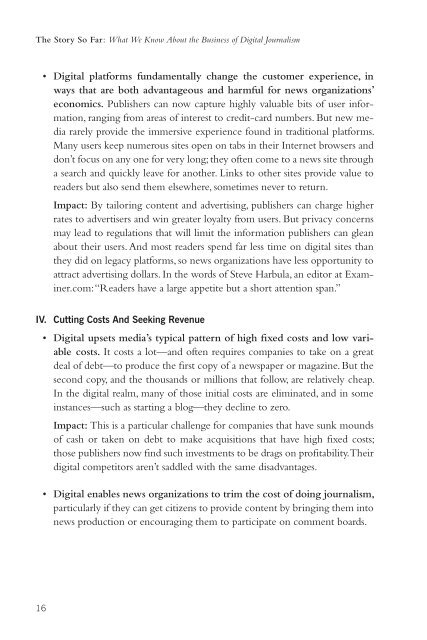What We Know About the Business of Digital Journalism
What We Know About the Business of Digital Journalism
What We Know About the Business of Digital Journalism
Create successful ePaper yourself
Turn your PDF publications into a flip-book with our unique Google optimized e-Paper software.
The Story So Far: <strong>What</strong> <strong>We</strong> <strong>Know</strong> <strong>About</strong> <strong>the</strong> <strong>Business</strong> <strong>of</strong> <strong>Digital</strong> <strong>Journalism</strong>• <strong>Digital</strong> platforms fundamentally change <strong>the</strong> customer experience, inways that are both advantageous and harmful for news organizations’economics. Publishers can now capture highly valuable bits <strong>of</strong> user information,ranging from areas <strong>of</strong> interest to credit-card numbers. But new mediararely provide <strong>the</strong> immersive experience found in traditional platforms.Many users keep numerous sites open on tabs in <strong>the</strong>ir Internet browsers anddon’t focus on any one for very long; <strong>the</strong>y <strong>of</strong>ten come to a news site througha search and quickly leave for ano<strong>the</strong>r. Links to o<strong>the</strong>r sites provide value toreaders but also send <strong>the</strong>m elsewhere, sometimes never to return.Impact: By tailoring content and advertising, publishers can charge higherrates to advertisers and win greater loyalty from users. But privacy concernsmay lead to regulations that will limit <strong>the</strong> information publishers can gleanabout <strong>the</strong>ir users. And most readers spend far less time on digital sites than<strong>the</strong>y did on legacy platforms, so news organizations have less opportunity toattract advertising dollars. In <strong>the</strong> words <strong>of</strong> Steve Harbula, an editor at Examiner.com:“Readers have a large appetite but a short attention span.”IV. Cutting Costs And Seeking Revenue• <strong>Digital</strong> upsets media’s typical pattern <strong>of</strong> high fixed costs and low variablecosts. It costs a lot—and <strong>of</strong>ten requires companies to take on a greatdeal <strong>of</strong> debt—to produce <strong>the</strong> first copy <strong>of</strong> a newspaper or magazine. But <strong>the</strong>second copy, and <strong>the</strong> thousands or millions that follow, are relatively cheap.In <strong>the</strong> digital realm, many <strong>of</strong> those initial costs are eliminated, and in someinstances—such as starting a blog—<strong>the</strong>y decline to zero.Impact: This is a particular challenge for companies that have sunk mounds<strong>of</strong> cash or taken on debt to make acquisitions that have high fixed costs;those publishers now find such investments to be drags on pr<strong>of</strong>itability. Theirdigital competitors aren’t saddled with <strong>the</strong> same disadvantages.• <strong>Digital</strong> enables news organizations to trim <strong>the</strong> cost <strong>of</strong> doing journalism,particularly if <strong>the</strong>y can get citizens to provide content by bringing <strong>the</strong>m intonews production or encouraging <strong>the</strong>m to participate on comment boards.16
















